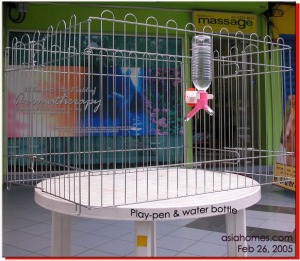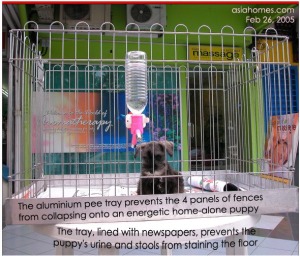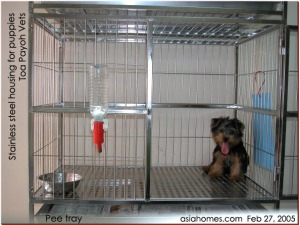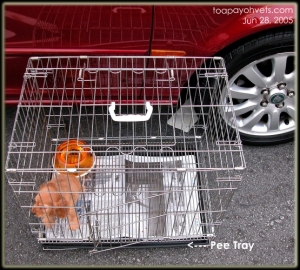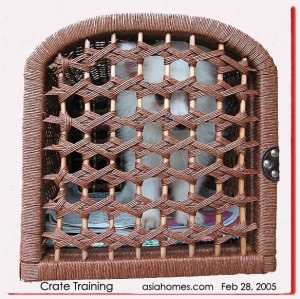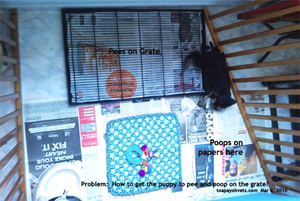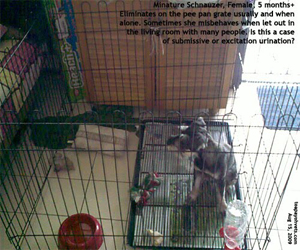TOILET TRAINING PUPPY IN THE CITY - How to train your
new puppy to pee and poop in the correct way
Dr Sing Kong Yuen
toapayohvets.com
Case 3/10
First written: March 4, 2005
Updated: April 3, 2015
TOP 3 MISTAKES OF
SINGAPOREANS
1. Assuming the puppy recognises the newspaper as the toilet location.
2. Give the puppy free access to the whole apartment.
3. No time to train the puppy properly. The owner travels
frequently.
Troubleshooting - Case study
No. 1
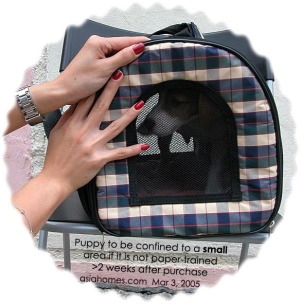
The puppy had free access to the whole apartment. Newspapers placed in the
living and dining rooms were ignored.
"We
put newspapers on the floor
in the living and dining rooms, but the puppy does will not poo and pee on
the papers !" the 16-year-old younger sister said as I gave him the second
vaccination and enquired about its toilet training. "We had the puppy for
over 4 weeks. It peed as often as ten times in one hour when it was
younger but now, less frequently."
1. This puppy does not associate the newspapers as the toilet area.
There are cases where the newly purchased puppy just go to the newspapers
to do its business without any training.
2. In this case, the puppy was free to roam the whole apartment.
3. It was 6 weeks old when purchased and was too young to be able to
control its bladder and bowel compared to being older.
Solutions for the busy owners
1. The puppy must be confined in the play pen again. Line the
whole floor with newspapers. The puppy may tear up the
papers and the owner may give up. It will take time to paper train
the puppy. After some time, one area of the papers will contain its
poo and pee as the puppy does not like to sleep in a dirty area.
2. Over a period of time, remove the papers so that only the toilet
area is covered by newspapers.
3. When you take the puppy out, observe the signs of passing urine.
Take it to the newspapers, say "pee here." Reward with a treat and
praise the puppy with a treat if it pees on the papers.
4. When the puppy is taken out to the bigger area but not the whole
apartment, place the newspaper with the puppy urine (2nd sheet of
newspaper) or with urine training solution on the floor.
5. Thoroughly remove all
smells of urine and poo from the tiled floors in the living and dining
rooms using a cleaning solution.
LOCATION
1. Indoors (balcony, spare bathroom, kitchen, living area, bedroom or
whole apartment).
2. Outdoors (grass area).
3. Indoors and Outdoors - Many pet owners confuse the young puppy as it is
immature and does not know what the owner wants. Also, the time to go out
to the grass area is not regular. Toilet training success is not
good.
TOILET TRAINING PRACTICES IN SINGAPORE
1. Newspapers* in a confined area like the play
pen, laundry room, bathroom, balcony or
kitchen area.
2. Free access to whole apartment.
3. Crate (cage) with door.
The floor level of the cage may be too high for the small breeds. May need
to lift the puppy into the cage. Confined the puppy inside the cage for
the first 7 days. Let it out under supervision. Catch it for signs of
wanting to go to the toilet. Put it inside the cage. Praise it for
success. Clean the flooring of the cage regularly but leave a bit of the
smell in the location where the puppy usually pees and poos.
4. Crate. Very few owners are aware of the usefulness of crate training.
If the puppy is 6 - 12 weeks old, every hour, take the puppy out to let it
pee and poo. If the puppy is around 12 weeks old, every 2 hours,
take it out to pee on newspapers in a confined area.
HOW LONG DOES IT TAKE?
1. Full-time training. Takes less than 7 days in some cases.
Some owners sleep with the puppy for the first 7 days. When it whines or
wants to go to the toilet, take it to the toilet area. Working
owners may need to apply for leave to focus on this toilet training.
2. Part-time training. Evenings and weekends for home-alone
puppies.
3. No training. Free access to whole apartment.
BEATING OR REWARDING THE PUPPY WHEN IT PEES OR POOS IN UNAPPROVED
LOCATIONS
1. Beating the puppy's backside with newspaper or hand.
Slapping the puppy's face for not going to the toilet in time. The
puppy runs away and is frightened of the owner. Two puppies with eye
injuries were treated by me.
2. Put nose in shit and tell puppy to go to right location.
The puppy runs away and is frightened of the owner.
3. Hit the floor with a roll of newspapers when the puppy does not go to
the toilet area. The puppy runs away and is frightened of the owner.
3. Reward the puppy with treats and praises when the puppy pees and
poos on the newspapers. The puppy is happy and looks forward
to the rewards.
TOILET AREA
1. Play pen (no door). Most commonly sold by pet shops. It is the cheapest
and some owners feel that the play pen will be of use only for a month or
two. Hence they do not wish to spend so much money. Newspapers cover floor
of the play pen.
2. Play pen + pee tray. (no door). Newspapers placed onto the pee tray.
3. Play pen + pee tray with wire flooring put inside the play pen.
Newspapers placed onto the pee tray.
4. Play pen (wooden frames) + door. Towel on one half of the floor.
Newspapers on the other half.
5. Pee tray with wire flooring above. Newspapers placed onto the pee
tray.
6. Pee tray. Newspapers placed onto the pee tray.
7. Leash on restricted floor area. Put newspaper and bedding.
8. Grass outside (ground-floor apartments or bring the puppy downstairs).
9. Cage. Stainless
steel ones are the most expensive.
10. Crate. This may be a puppy carrier or cage with 3 sides
and front door.
AIDS
1. Urine training liquid available from pet shops and sprayed onto
newspapers.
2. 2nd sheet of newspapers stained with the puppy's urine.
3. No water after 8 p.m.
4. Two feeds a day. If the puppy does not eat within 15 minutes,
take away the food**.
Most dog books recommend 3 to 4 feeds a day for puppies less than 20 weeks
old but Singapore pet shop operators recommend twice a day.
5. The water bottle attached to the play pen or fencing is usually
recommended by the pet shop operator for new puppies.
6. Dual-nozzle water bottle or two water bottles (one inside and one
outside) may be need to ensure that the puppy drinks water.
7. Water bowls spill water onto the floor as the puppy plays with
the bowl. Heavy bowls may not be available at the pet shop but the puppy
may play with the water.
8. Cleaning liquids to neutralise the smell of pee and poo on tiled
floors.
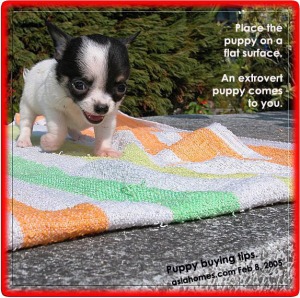
TWO PUPPIES
1. Role model of older puppy. May work or may not work.
2. No role model for 2 siblings. One may want to be clean but the other
simply poos and pees anywhere in the play pen or confined area.
3. Toilet train as for sole puppy by separating them in confined
areas. This may not be practical.
* Newspapers mentioned in this
report include
1. Puppy Training Pads (cost around US$0.70 per piece. More
absorbent and may be used for 2 days) Some puppy training pads have
scent to attract the puppies to pee on it. Some pads require additional
urine training liquid to attract the puppy.
2. Pieces of old rugs/carpet. The puppy loves the feel of
soft areas for doing its business.
** For Chihuahuas and mini-Maltese, you will need to be careful not
to remove the food if it does not eat within 15 minutes. Make sure it eats
the food. Some of the smaller breeds are prone to fainting if it
does not eat.
Puppy-proofing the toilet area. If the puppy is confined to the
laundry room, make sure that the electrical switches and wires are not
available for the puppy to chew. A case of a washing machine
malfunction was due to the wires being chewed off by the puppy.
Detergents, plastic bags and other things to be placed away from the
puppy.
Other articles
asiahomes.com/singaporetpvet/1_newsletter.htm
asiahomes.com/dev/Atomic_First_Toys.htm
toapayohvets.com/sinpets/040809FAQ.htm
This webpage:
sinpets.com/stories/050303Toilet_training_mistakes.htm
Original article:
sinpets.com/050303Toilet_training_mistakes_Apr315.htm
www.toapayohvets.com |


